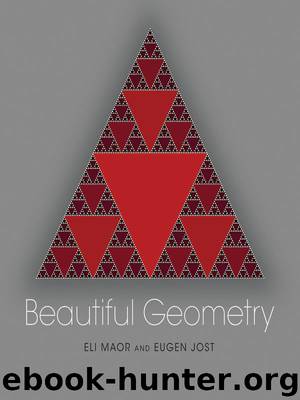Beautiful Geometry by Maor Eli; Jost Eugen;

Author:Maor, Eli; Jost, Eugen;
Language: eng
Format: epub
Publisher: Princeton University Press
Published: 2013-03-11T16:00:00+00:00
NOTE:
1. For a full account of Archimedes’s method, see The Works of Archimedes, edited by T. L. Heath (New York: Dover. 1953), pp. 91–98.
28
The Digit Hunters
In the second century BCE, during Archimedes’s lifetime, the Hindu-Arabic numeration system was still more than a thousand years in the future. So Archimedes had to do all his calculations in a strange hybrid of the Babylonian sexagesimal (base 60) system and the Greek system, in which each letter of the alphabet had a numerical value (alpha = 1, beta = 2, and so on). Today, of course, we associate the value of π with its decimal expansion—a nonrepeating, seemingly random string of digits that goes on forever. Terminate this expansion after any number of digits, and you’ll get only an approximation of π.
So, where should we stop? For many daily practical tasks, the simple fraction will suffice, differing from π by just 0.04 percent. The Chinese mathematician Zu Chongzhi (Tsu Ch’ung-Chih, 429–501) around 480 CE discovered the nice approximation , accurate to six places—that is, to the nearest millionth. The Dutch-German mathematician Ludolph van Ceulen (1540–1610) computed π to 20 decimal places, using Archimedes’s method with polygons of 60 × 229 sides and spending much of his professional life on the task (he later improved his calculations to 35 places). After Van Ceulen’s death, his widow reportedly had the number inscribed on his tombstone in Leiden, but all traces of it have been lost. Here it is:
Download
This site does not store any files on its server. We only index and link to content provided by other sites. Please contact the content providers to delete copyright contents if any and email us, we'll remove relevant links or contents immediately.
The Secret History by Donna Tartt(18134)
Red Sparrow by Jason Matthews(5190)
Harry Potter 02 & The Chamber Of Secrets (Illustrated) by J.K. Rowling(3548)
In a Sunburned Country by Bill Bryson(3359)
Drawing Cutting Edge Anatomy by Christopher Hart(3287)
Figure Drawing for Artists by Steve Huston(3266)
The Daily Stoic by Holiday Ryan & Hanselman Stephen(3103)
Harry Potter and the Prisoner of Azkaban (Book 3) by J. K. Rowling(3099)
Japanese Design by Patricia J. Graham(2995)
The Roots of Romanticism (Second Edition) by Berlin Isaiah Hardy Henry Gray John(2815)
Make Comics Like the Pros by Greg Pak(2752)
Stacked Decks by The Rotenberg Collection(2682)
Harry Potter and the Deathly Hallows (7) by J.K. Rowling(2541)
Draw-A-Saurus by James Silvani(2497)
Tattoo Art by Doralba Picerno(2483)
On Photography by Susan Sontag(2477)
Foreign Devils on the Silk Road: The Search for the Lost Treasures of Central Asia by Peter Hopkirk(2384)
Churchill by Paul Johnson(2358)
The Daily Stoic by Ryan Holiday & Stephen Hanselman(2336)
